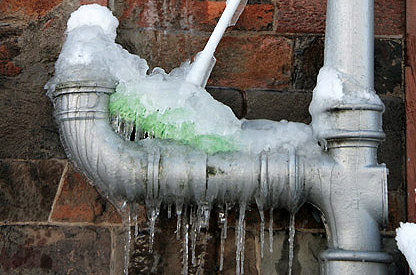Shielding Your Pipes from Cold Weather Damage: Essential Tips
Shielding Your Pipes from Cold Weather Damage: Essential Tips
Blog Article
We've come across this article on 6 Ways to Prevent Frozen Pipes listed below on the web and believe it made good sense to quickly share it with you on this page.
:strip_icc()/snow-outdoor-faucet-pipes-4af65d1e5e904fb1aa7bf74071fe5d89.jpg)
Cold weather can damage your pipes, particularly by freezing pipelines. Here's just how to stop it from occurring and what to do if it does.
Intro
As temperatures drop, the threat of icy pipes rises, potentially resulting in costly repair services and water damage. Recognizing just how to prevent icy pipes is critical for homeowners in cool climates.
Prevention Tips
Shielding at risk pipelines
Cover pipelines in insulation sleeves or make use of warm tape to protect them from freezing temperatures. Concentrate on pipes in unheated or external areas of the home.
Heating methods
Maintain indoor areas sufficiently heated, especially areas with pipes. Open up cabinet doors to permit warm air to distribute around pipes under sinks.
How to determine icy pipelines
Look for reduced water circulation from faucets, uncommon odors or noises from pipes, and noticeable frost on exposed pipes.
Long-Term Solutions
Architectural modifications
Consider rerouting pipelines far from exterior wall surfaces or unheated locations. Add added insulation to attics, cellars, and crawl spaces.
Upgrading insulation
Invest in top notch insulation for pipes, attic rooms, and walls. Proper insulation helps maintain constant temperature levels and reduces the risk of frozen pipes.
Safeguarding Outside Pipes
Yard pipes and exterior faucets
Detach and drain pipes yard pipes before wintertime. Install frost-proof spigots or cover outdoor faucets with protected caps.
Comprehending Frozen Pipes
What triggers pipelines to ice up?
Pipelines ice up when exposed to temperatures below 32 ° F (0 ° C) for extended durations. As water inside the pipes freezes, it increases, putting pressure on the pipe walls and potentially triggering them to rupture.
Risks and problems
Frozen pipes can cause water disruptions, property damages, and pricey repair work. Ruptured pipelines can flood homes and create considerable structural damages.
Signs of Frozen Water Lines
Recognizing icy pipes early can avoid them from rupturing.
What to Do If Your Pipelines Freeze
Immediate activities to take
If you think frozen pipes, keep taps open to relieve stress as the ice melts. Utilize a hairdryer or towels taken in warm water to thaw pipes slowly.
Final thought
Avoiding icy pipes calls for aggressive procedures and quick reactions. By understanding the reasons, signs, and preventive measures, homeowners can protect their pipes during cold weather.
6 Proven Ways to Prevent Frozen Pipes and Protect Your Home
Disconnect and Drain Garden Hoses
Before winter arrives, start by disconnecting your garden hoses and draining any remaining water. Close the shut-off valves that supply outdoor hose bibs and leave the outdoor faucet open to allow any residual water to drain. For extra protection, consider using faucet covers throughout the colder months. It’s also important to drain water from any sprinkler supply lines following the manufacturer’s directions.
Insulate Exposed Pipes
Insulating your pipes is an effective way to prevent freezing. Pipe insulation is readily available at home improvement stores and is relatively inexpensive. Pay close attention to pipes in unheated areas such as the attic, basement, crawl spaces, or garage. Apply foam insulation generously to create a buffer against the cold. You can also wrap your pipes in heat tape or thermostat-controlled heat cables for added warmth.
Seal Air Leaks
Inspect your home for any cracks or openings that could let in cold air. Seal any holes around the piping in interior or exterior walls, as well as the sill plates where your home rests on its foundation. Additionally, make sure to keep your garage door closed unless you’re entering or exiting. Leaving it open creates a significant air leak that can lead to frozen pipes.
Allow Warm Air Circulation
During cold snaps, it’s essential to allow warm air to circulate evenly throughout your home. Leave interior doors ajar to promote better airflow. Open kitchen and bathroom cabinets to help distribute heat consistently around the rooms. If you have small children or pets, be sure to remove any household chemicals or potentially harmful cleaners from open cabinets for safety.
Let Faucets Drip
A small trickle of water can make a big difference in preventing ice formation inside your pipes. When temperatures drop significantly, start a drip of water from all faucets served by exposed pipes. This continuous flow helps prevent the water from freezing. Additionally, running a few faucets slightly can relieve pressure inside the pipes, reducing the chances of a rupture if the water inside does freeze.
https://choateshvac.com/6-proven-ways-to-prevent-frozen-pipes-and-protect-your-home/

I recently found that content on How To Avoid Freezing Pipes when doing a search on the search engines. Do you know about somebody else who is intrigued by the topic? Do not hesitate to promote it. Thanks so much for your time invested reading it.
Set Up An Appointment Report this page